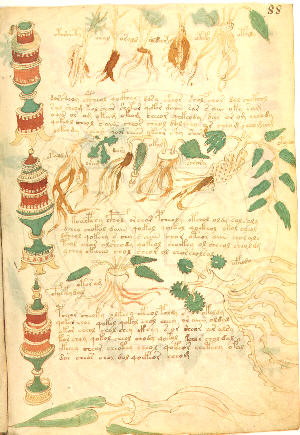You are here: Foswiki>Andypublic Web>VoynichManuscript (09 Feb 2005, andyp)Edit Attach
Imagine a book which contains a secret language and mysterious drawings, a book whose meaning has eluded the finest cryptographers and linguists for at least 400 years. This is the Voynich Manuscript.
 The Voynich Manuscript is a document with a long history. It was rediscovered in 1912 by Wilfrid Voynich:
The Voynich Manuscript is a document with a long history. It was rediscovered in 1912 by Wilfrid Voynich:
Sources:
 The Voynich Manuscript is a document with a long history. It was rediscovered in 1912 by Wilfrid Voynich:
The Voynich Manuscript is a document with a long history. It was rediscovered in 1912 by Wilfrid Voynich:
While examining the manuscripts, with a view to the acquisition of at least a part of the collection, my attention was especially drawn by one volume. It was such an ugly duckling compared with the other manuscripts, with their rich decorations in gold and colors, that my interest was aroused at once. I found that it was written entirely in cipher. Even a necessarily brief examination of of the vellum upon which it was written, the calligraphy, the drawings and the pigments suggested to me as the origin the latter part of the thirteenth century. The drawings indicated it to be an encyclopedic work on natural philosophy. [...] the fact that this was a thirteenth century manuscript in cipher convinced me that it must be a work of exceptional importance, and to my knowledge the existence of a manuscript of such an early date written entirely in cipher was unkown, so I included it among the manuscripts which I purchased from this collection.Yale has some sample pages online at http://inky.library.yale.edu/voy/voy2.html There seems to be agreement that the text contains at least two seperate "languages" - either different ciphers, authors or plain text languages. This is born out by statistical analysis and examination of handwriting. During my research, I came across these fascinating representations of texts in various languages including the Voynich text, with letters coloured according to their entropy (i.e. how easy they are to predict). So, for example, in English, the letters in the word "the" are pretty predictable - most of the time, a "th" is followed by an "e". Similarly for "qu".
- English (War of the Worlds) - http://www.dcc.unicamp.br/~stolfi/voynich/98-07-09-local-entropy/engl.html
- Voynich text http://www.dcc.unicamp.br/~stolfi/voynich/98-07-09-local-entropy/voyn.html
- Main page including links to other languages - http://www.dcc.unicamp.br/~stolfi/voynich/98-07-09-local-entropy/
Sources:
- http://en.wikipedia.org/wiki/Voynich_manuscript - Good overview of the theories
- http://www.voynich.nu/ - Brilliant resource!
- http://web.bham.ac.uk/G.Landini/evmt/ - European Voynich Manuscript Transcription Project
- http://www.dcc.unicamp.br/~stolfi/voynich/ - Analyses of the text including statistics and visualisations
- http://www.totse.com/en/privacy/encryption/voynich.html - great punk writing style and the kind of overview you'd get from someone well informed that you met in a pub
- http://www.geocities.com/SoHo/Cafe/2260/voynich.html - Badly spelt but interesting overview with speculations as to the language, cipher and authors of the text
- http://www.diac.com/~ekwall2/voynich/grossman.shtml - Nice history, by someone who's seen the actual book
| I | Attachment | Action | Size | Date | Who | Comment |
|---|---|---|---|---|---|---|
| |
Voynich_roots.jpg | manage | 40 K | 10 Apr 2001 - 12:39 | Unknown User | Copyright Yale University ?? |
Edit | Attach | Print version | History: r3 < r2 < r1 | Backlinks | View wiki text | Edit wiki text | More topic actions
Topic revision: r3 - 09 Feb 2005, andyp
Favourite Pages
My Blog
Best Of Blog 2007
Best Of Blog 2005 Birmingham,
How to be Happy,
Influenza Pandemic,
Moseley Tornado,
Misty's Big Adventure,
Street Furniture Stickers,
Weird Internet Animations
Other People's Blogs
Birmingham Bloggers Danger! High Postage,
Parallax View,
Pete Ashton,
Silent Words Speak Loudest
Please don't ask for a sidebar link as a refusal often offends. Editorial Policy
My Blog
Best Of Blog 2007
Best Of Blog 2005 Birmingham,
How to be Happy,
Influenza Pandemic,
Moseley Tornado,
Misty's Big Adventure,
Street Furniture Stickers,
Weird Internet Animations
Other People's Blogs
Birmingham Bloggers Danger! High Postage,
Parallax View,
Pete Ashton,
Silent Words Speak Loudest
Please don't ask for a sidebar link as a refusal often offends. Editorial Policy
 Copyright © by the contributing authors. All material on this collaboration platform is the property of the contributing authors.
Copyright © by the contributing authors. All material on this collaboration platform is the property of the contributing authors. Ideas, requests, problems regarding Foswiki? Send feedback


